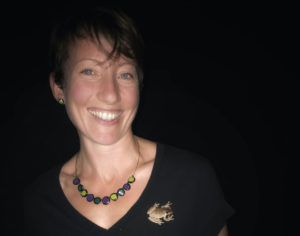A new study that examines 25 years of data on land-use change, bat behaviour, and spillover of Hendra virus from bats to horses in subtropical Australia has revealed that human activities are causing bats to adopt behaviours previously linked to short-term nutritional stress, and that this change in behaviour is increasing risk of Hendra virus spillover.
The team of researchers, led by Dr Alison Peel from Griffith University, Dr Peggy Eby from University of New South Wales and Prof Raina Plowright from Cornell University, highlight in the Nature research that interactions between habitat destruction and climate are leading to bats persisting in agricultural areas, where they can come into contact with horses.

Dr Alison Peel.
At a global scale, the major challenge has been to identify what causes pathogens to spill over from wildlife into human populations to generate a pandemic threat. Previous correlational studies associate spillover with broad-scale habitat destruction and encroachment of people into natural landscapes, increasing opportunities for contact between wildlife, domestic animals and people.
“These studies give broad assessments of where spillover might happen, and some general hypotheses about how and why. However, what’s missing is the detail needed to predict periods when spillover risk is high,” Dr Peel said.
Dr Peel, from Griffith’s Centre for Planetary Health and Food Security, said one limitation was that there were few examples where long-term data are available to make connections among spillovers, wildlife ecology and behaviour, and viral dynamics.
“We use 25 years of data on climate, land-use change, bat behaviour, and spillover of Hendra virus from bats to horses to address these gaps,” Dr Peel said.
The study highlights that habitat destruction, agriculture and people were important in broadly determining where risk was high — but not simply because encroachment directly led to increased opportunities for contact as previously assumed.
Instead, the researchers found that flying foxes responded to land-use change by shifting their distribution and invoking behaviours that they would normally use to avoid climate-driven starvation associated with El Niño events, such as feeding on introduced plants in horse paddocks. This was causing them to shift into agricultural areas that did not provide native food over winter.

Dr Peggy Eby.
“Flying foxes track nectar flow in native forests over vast distances, and play a critical ecosystem role in pollinating our native trees. When large areas of eucalypts burst into flower, flying foxes congregate in roosts of >100,000 individuals to enjoy the abundant food,” Dr Eby said.
“In our study, we show that large winter flowering events have a protective effect on the risk of spillover and are therefore critical to the health of horses and people as well as bats. We found that no Hendra virus spillovers have been detected at times when flowering is abundant.”
Extensive clearing of forests that flower in winter has led to a reduction in the number of years when abundant flowering occurs, reducing the reliability of this natural source of protection and increasing the risk of spillovers.
“We used modelling to integrate our long-term data into a framework that allows us to understand the how, why and when of viral spillover. We identified climate thresholds that enable us to predict periods of high risk of Hendra virus spillover up to two years in advance,” Dr Eby said.
“Identifying the protective effect of mass winter flowering events offers hope — by replacing critical habitat that has been destroyed we can ensure that abundant winter flowering occurs more reliably.
“We propose that restoration of this critical habitat will restore functioning ecosystems, improve the health of flying foxes, reduce their reliance on urban and agricultural areas, and protect horses and people against spillover of Hendra and other viruses.”
The findings ‘Pathogen spillover driven by rapid changes in bat ecology’ have been published in Nature.
